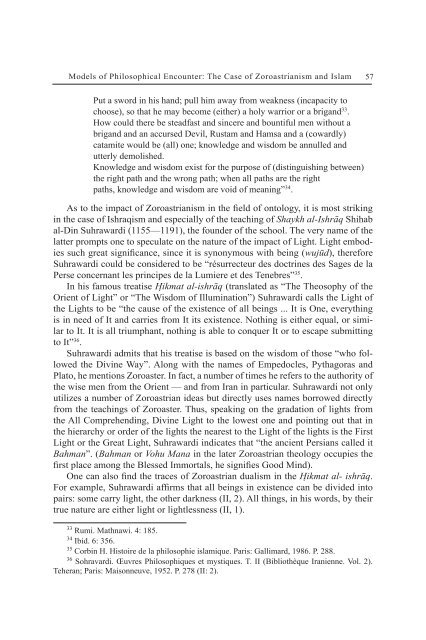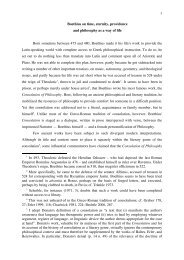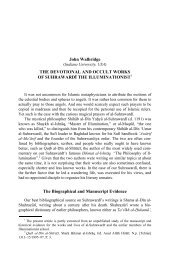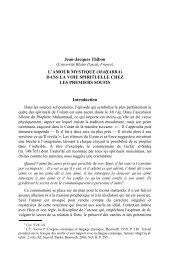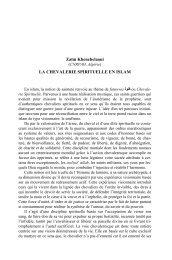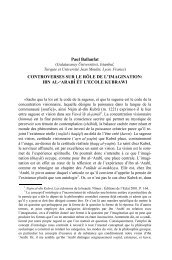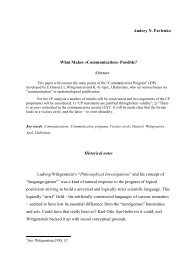Marietta Stepanyants (Institute of Philosophy, Russian Academy of ...
Marietta Stepanyants (Institute of Philosophy, Russian Academy of ...
Marietta Stepanyants (Institute of Philosophy, Russian Academy of ...
You also want an ePaper? Increase the reach of your titles
YUMPU automatically turns print PDFs into web optimized ePapers that Google loves.
Models <strong>of</strong> Philosophical Encounter: The Case <strong>of</strong> Zoroastrianism and Islam 57<br />
Put a sword in his hand; pull him away from weakness (incapacity to<br />
choose), so that he may become (either) a holy warrior or a brigand 33 .<br />
How could there be steadfast and sincere and bountiful men without a<br />
brigand and an accursed Devil, Rustam and Hamsa and a (cowardly)<br />
catamite would be (all) one; knowledge and wisdom be annulled and<br />
utterly demolished.<br />
Knowledge and wisdom exist for the purpose <strong>of</strong> (distinguishing between)<br />
the right path and the wrong path; when all paths are the right<br />
paths, knowledge and wisdom are void <strong>of</strong> meaning” 34 .<br />
As to the impact <strong>of</strong> Zoroastrianism in the field <strong>of</strong> ontology, it is most striking<br />
in the case <strong>of</strong> Ishraqism and especially <strong>of</strong> the teaching <strong>of</strong> Shaykh al-Ishrāq Shihab<br />
al-Din Suhrawardi (1155—1191), the founder <strong>of</strong> the school. The very name <strong>of</strong> the<br />
latter prompts one to speculate on the nature <strong>of</strong> the impact <strong>of</strong> Light. Light embodies<br />
such great significance, since it is synonymous with being (wujūd), therefore<br />
Suhrawardi could be considered to be “résurrecteur des doctrines des Sages de la<br />
Perse concernant les principes de la Lumiere et des Tenebres” 35 .<br />
In his famous treatise Hikmat al-ishrāq (translated as “The Theosophy <strong>of</strong> the<br />
Orient <strong>of</strong> Light” or “The Wisdom <strong>of</strong> Illumination”) Suhrawardi calls the Light <strong>of</strong><br />
the Lights to be “the cause <strong>of</strong> the existence <strong>of</strong> all beings ... It is One, everything<br />
is in need <strong>of</strong> It and carries from It its existence. Nothing is either equal, or similar<br />
to It. It is all triumphant, nothing is able to conquer It or to escape submitting<br />
to It” 36 .<br />
Suhrawardi admits that his treatise is based on the wisdom <strong>of</strong> those “who followed<br />
the Divine Way”. Along with the names <strong>of</strong> Empedocles, Pythagoras and<br />
Plato, he mentions Zoroaster. In fact, a number <strong>of</strong> times he refers to the authority <strong>of</strong><br />
the wise men from the Orient — and from Iran in particular. Suhrawardi not only<br />
utilizes a number <strong>of</strong> Zoroastrian ideas but directly uses names borrowed directly<br />
from the teachings <strong>of</strong> Zoroaster. Thus, speaking on the gradation <strong>of</strong> lights from<br />
the All Comprehending, Divine Light to the lowest one and pointing out that in<br />
the hierarchy or order <strong>of</strong> the lights the nearest to the Light <strong>of</strong> the lights is the First<br />
Light or the Great Light, Suhrawardi indicates that “the ancient Persians called it<br />
Bahman”. (Bahman or Vohu Mana in the later Zoroastrian theology occupies the<br />
first place among the Blessed Immortals, he signifies Good Mind).<br />
One can also find the traces <strong>of</strong> Zoroastrian dualism in the Hikmat al- ishrāq.<br />
For example, Suhrawardi affirms that all beings in existence can be divided into<br />
pairs: some carry light, the other darkness (II, 2). All things, in his words, by their<br />
true nature are either light or lightlessness (II, 1).<br />
33 Rumi. Mathnawi. 4: 185.<br />
34 Ibid. 6: 356.<br />
35 Corbin H. Histoire de la philosophie islamique. Paris: Gallimard, 1986. P. 288.<br />
36 Sohravardi. Œuvres Philosophiques et mystiques. T. II (Bibliothèque Iranienne. Vol. 2).<br />
Teheran; Paris: Maisonneuve, 1952. P. 278 (II: 2).


